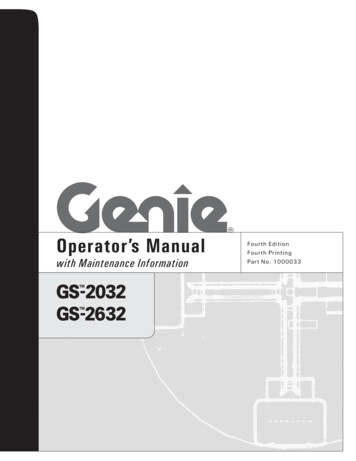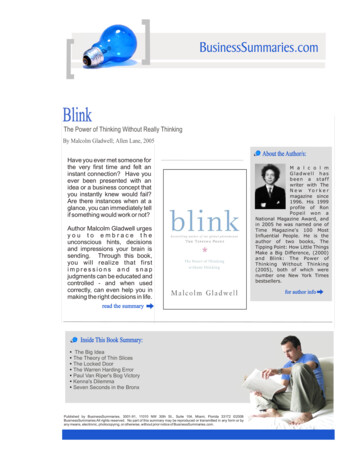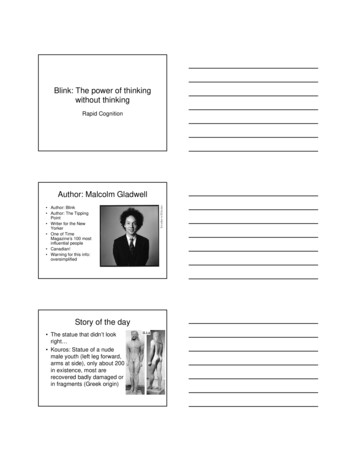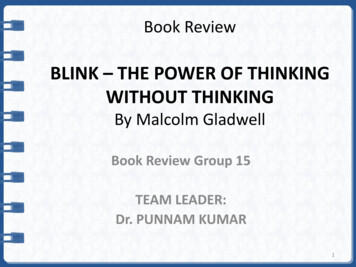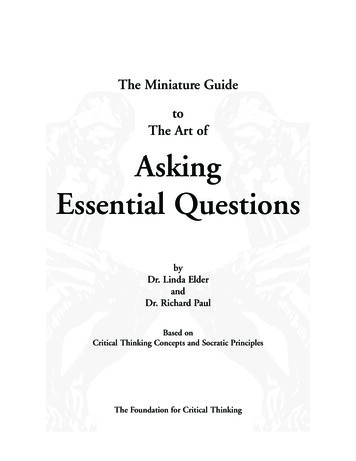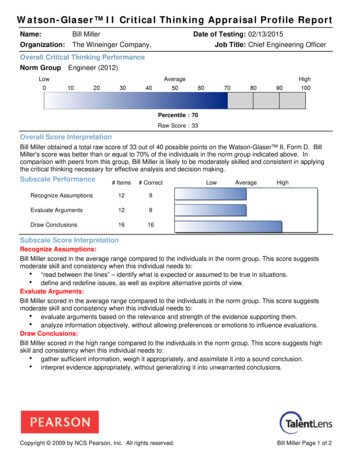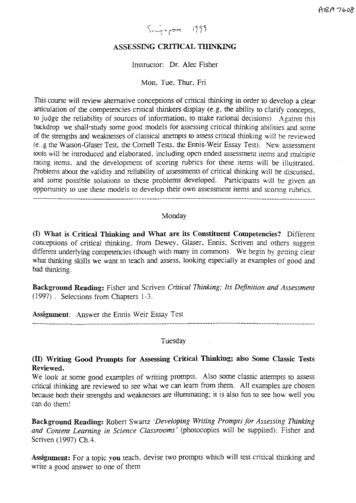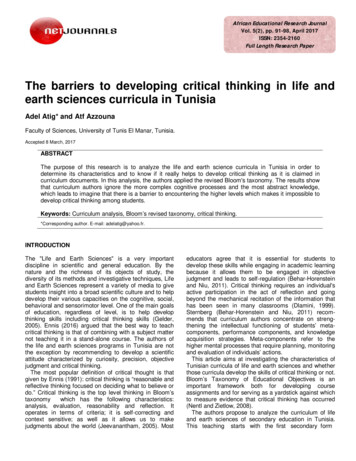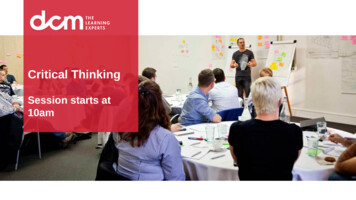
Transcription
fourth EDItIONfourthEDItIONThis clear, learner-friendly text helps today’s students bridge the gap betweenIts comprehensiveness allows instructors to tailor the material to theirindividual teaching styles, resulting in an exceptionally versatile text.Highlights of the Fourth Edition:Additional readings and essays in a new Appendix as well as in Chapters 7and 8 nearly double the number of readings available for critical analysis andclassroom discussion.An online chapter, available on the instructor portion of the book’s Web site,addresses critical reading, a vital skill for success in college and beyond.Visit www.mhhe.com/bassham4efor a wealth of additional student and instructor resources.Bassham I IrwinNardone I WallaceNew and updated exercises and examples throughout the text allow studentsto practice and apply what they learn.MD DALIM #1062017 12/13/09 CYAN MAG YELO BLKChapter 12 features an expanded and reorganized discussion of evaluatingInternet sources.Critical Thinkingthinking, using real-world examples and a proven step-by-step approach.A student ' s IntroductionA student's Introductioneveryday culture and critical thinking. It covers all the basics of criticalCritical ThinkingBa ssha mI Irwin I Nardone I Wall ace
CRITICAL THINKINGA STUDENT’S INTRODUCTIONFOURTH EDITIONGregory BasshamWilliam IrwinHenry NardoneJames M. WallaceKing’s CollegeTMbas07437 fm i-xvi.indd i11/24/09 9:53:56 AM
TMPublished by McGraw-Hill, an imprint of The McGraw-Hill Companies, Inc., 1221 Avenue of the Americas,New York, NY 10020. Copyright 2011, 2008, 2005, 2002. All rights reserved. No part of this publication may bereproduced or distributed in any form or by any means, or stored in a database or retrieval system, without the priorwritten consent of The McGraw-Hill Companies, Inc., including, but not limited to, in any network or other electronic storage or transmission, or broadcast for distance learning.This book is printed on acid-free paper.1 2 3 4 5 6 7 8 9 0 DOC/DOC 0ISBN: 978-0-07-340743-2MHID: 0-07-340743-7Vice President, Editorial: Michael RyanDirector, Editorial: Beth MejiaSponsoring Editor: Mark GeorgievMarketing Manager: Pam CooperManaging Editor: Nicole BridgeDevelopmental Editor: Phil ButcherProject Manager: Lindsay BurtManuscript Editor: Maura P. BrownDesign Manager: Margarite ReynoldsCover Designer: Laurie EntringerProduction Supervisor: Louis SwaimComposition: 11/12.5 Bembo by MPS Limited, A Macmillan CompanyPrinting: 45# New Era Matte, R. R. Donnelley & SonsCover Image: Brand X/JupiterImagesCredits: The credits section for this book begins on page C-1 and is considered an extension of the copyright page.Library of Congress Cataloging-in-Publication DataCritical thinking : a student’s introduction / Gregory Bassham . . . [et al.].—4th ed.p. cm.Includes bibliographical references and index.ISBN 978-0-07-340743-2 (alk. paper)1. Critical thinking—Textbooks. I. Bassham, Gregory, 1959–B809.2.C745 2010160—dc222009034761The Internet addresses listed in the text were accurate at the time of publication. The inclusion of a Web site doesnot indicate an endorsement by the authors or McGraw-Hill, and McGraw-Hill does not guarantee the accuracy ofthe information presented at these sites.www.mhhe.combas07437 fm i-xvi.indd ii11/24/09 9:53:56 AM
For Enrico, Eric, Nicole, Dylan,Catherine, Daniel, and Katebas07437 fm i-xvi.indd iii11/24/09 9:53:57 AM
bas07437 fm i-xvi.indd iv11/24/09 9:53:57 AM
CONTENTSA Word to Students xiPreface xiiiCHAPTER 1Introduction to Critical Thinking 1What Is Critical Thinking? 1Critical Thinking Standards 2Clarity 2Precision 2Accuracy 3Relevance 3Consistency 4Logical Correctness 5Completeness 6Fairness 6The Benefits of Critical Thinking 7Critical Thinking in the Classroom 7Critical Thinking in the Workplace 9Critical Thinking in Life 9Barriers to Critical Thinking 10Egocentrism 11Sociocentrism 13Unwarranted Assumptions and Stereotypes 16Relativistic Thinking 19Wishful Thinking 24Characteristics of a Critical Thinker 25vbas07437 fm i-xvi.indd v11/26/09 6:18:25 PM
viContentsCHAPTER 2Recognizing Arguments 29What Is an Argument? 29Identifying Premises and ConclusionsWhat Is Not an Argument? 40Reports 40Unsupported Assertions 41Conditional Statements 41Illustrations 43Explanations 43CHAPTER 333Basic Logical Concepts 53Deduction and Induction 53How Can We Tell Whether an Argument Is Deductive orInductive? 56The Indicator Word Test 57The Strict Necessity Test 58The Common Pattern Test 58The Principle of Charity Test 59Exceptions to the Strict Necessity Test 61Common Patterns of Deductive Reasoning 62Hypothetical Syllogism 62Categorical Syllogism 65Argument by Elimination 66Argument Based on Mathematics 66Argument from Definition 67Common Patterns of Inductive Reasoning 67Inductive Generalization 68Predictive Argument 68Argument from Authority 69Causal Argument 69Statistical Argument 70Argument from Analogy 70Deductive Validity 73Inductive Strength 77CHAPTER 4Language 86Finding the Right Words: The Need for Precision 86Vagueness 87Overgenerality 88Ambiguity 89bas07437 fm i-xvi.indd vi11/24/09 9:53:57 AM
ContentsThe Importance of Precise Definitions 93Types of Definitions 95Strategies for Defining 97Rules for Constructing Good Lexical DefinitionsEmotive Language: Slanting the Truth 107The Emotive Power of Words 108Euphemisms and Political Correctness 114CHAPTER 5vii100Logical Fallacies—I 119The Concept of Relevance 119Fallacies of Relevance 121Personal Attack (Ad Hominem) 122Attacking the Motive 123Look Who’s Talking ( Tu Quoque) 124Two Wrongs Make a Right 125Scare Tactics 127Appeal to Pity 128Bandwagon Argument 128Straw Man 129Red Herring 130Equivocation 131Begging the Question 132CHAPTER 6Logical Fallacies—II 140Fallacies of Insufficient Evidence 140Inappropriate Appeal to Authority 140Appeal to Ignorance 144False Alternatives 145Loaded Question 146Questionable Cause 147Hasty Generalization 149Slippery Slope 150Weak Analogy 151Inconsistency 154CHAPTER 7Analyzing Arguments 164Diagramming Short Arguments 164Tips on Diagramming Arguments 169Summarizing Longer Arguments 175Paraphrasing 176bas07437 fm i-xvi.indd vii11/28/09 11:42:14 AM
viiiContentsFinding Missing Premises and Conclusions 180Summarizing Extended Arguments 182Common Mistakes to Avoid in Standardizing Arguments 187CHAPTER 8Evaluating Arguments and Truth Claims 195When Is an Argument a Good One? 195What “Good Argument” Does Not Mean 195What “Good Argument” Does Mean 196When Is It Reasonable to Accept a Premise? 198Refuting Arguments 203Appendix: Sample Critical Essay 219CHAPTER 9A Little Categorical Logic 225Categorical Statements 225Translating into Standard Categorical FormCategorical Syllogisms 237CHAPTER 10230A Little Propositional Logic 252Conjunction 253Conjunction and Validity 256Negation 261Deeper Analysis of Negation and ConjunctionDisjunction 271Conditional Statements 276CHAPTER 11265Inductive Reasoning 285Introduction to Induction 285Inductive Generalizations 286Evaluating Inductive Generalizations 288Opinion Polls and Inductive Generalizations 292Statistical Arguments 296Reference Class 300Induction and Analogy 303What Is an Analogy? 303How Can We Argue by Analogy? 303bas07437 fm i-xvi.indd viii12/2/09 2:26:59 PM
ContentsixEvaluating Arguments from Analogy 305Arguing by Analogy 312Induction and Causal Arguments 313Correlation and Cause 317A Few Words about Probability 320A Closer Look at a Priori Probability 322CHAPTER 12Finding, Evaluating, and UsingSources 330Finding Sources 333Refining Your Search: Questions and Keywords 334Directional Information 336Informational Sources 338Evaluating Sources 341Content: Facts and Everything Else 342The Author and the Publisher 347The Audience 352Evaluating Internet Sources 353Taking Notes 361Bibliographical Information 361Content Notes: Quotes, Summaries, and Paraphrases 362Using Sources 372Acknowledging Sources 372Incorporating Sources 376CHAPTER 13Writing Argumentative Essays 382Writing a Successful Argument 384Before You Write 385Know Yourself 385Know Your Audience 386Choose and Narrow Your Topic 390Write a Sentence That Expresses Your Claim 393Gather Ideas: Brainstorm and Research 394Organize Your Ideas 400Organize by Methods of Development 403Writing the First Draft 406Provide an Interesting Opening 407Include a Thesis Statement 408Develop Your Body Paragraphs 409Provide a Satisfying Conclusion 410bas07437 fm i-xvi.indd ix11/24/09 9:53:57 AM
xContentsAfter the First Draft 412Read What You Have Written and Revise 412Consider What You Have Not Written and Revise 412Show Your Work 413Edit Your Work 413Hand It In 413Sample Argumentative Essay 414CHAPTER 14Thinking Critically about the Media 425The Mass Media 425The News Media 426The Importance of Context 426Getting Us to Pay Attention: What Really Drives the MediaKeeping Our Interest: The News as Entertainment 432How the Media Entertain Us 433Slanting the News 441Media Literacy 445Advertising 447What Ads Do 448Defenses of Advertising 450Criticisms of Advertising 450Common Advertising Ploys 452CHAPTER 15430Science and Pseudoscience 461The Basic Pattern of Scientific Reasoning 461The Limitations of Science 468How to Distinguish Science from Pseudoscience 470A Case Study in Pseudoscientific Thinking: Astrology482Appendix: Essays for Critical Analysis A-1Notes N-1Answers to Selected Exercises ANS-1Credits C-1Index I-1bas07437 fm i-xvi.indd x11/24/09 9:53:57 AM
A WORD TO STUDENTSLet’s be honest. Very few of your college textbooks will change your life.But this one truly can.This book will make you a better thinker. It will sharpen your mind,clarify your thoughts, and help you make smarter decisions.We’ll teach you—step by step—how to analyze issues, reason logically,and argue effectively. With effort on your part, this book will hone the thinking and reasoning skills you need to succeed in college, in your career, and inlife.Critical thinking is what college is all about. College is not about cramming students’ heads with facts. It’s about teaching students to think. Andthat’s precisely what this book is designed to do. It will help you developthe skills and dispositions you need to become an independent, self-directedthinker and learner.Collectively, the four authors of this textbook have been teaching critical thinking for over 60 years. Teaching critical thinking is what we do. It’sour passion. We’ve seen how critical thinking can change lives.But you’ll only get out of this course what you put into it. Becoming acritical thinker is hard work. Sometimes working through this book will feela little like boot camp. There’s a reason for this: No pain, no gain. Becominga master thinker means toning up your mental muscles and acquiring habitsof careful, disciplined thinking. This requires effort, and practice.That’s why the heart of this textbook is the exercises. There are lots ofthese, and all have been carefully selected and class-tested. You need to do theexercises. As many as you can. (Or at least all that your instructor assigns.) Dothe exercises, then check the answers at the back of the book. Practice. Makemistakes. Get feedback. And watch yourself improve. That’s how you’ll workthe mental flab off and develop lasting habits of clear, rigorous thinking.Critical thinking is an adventure. Becoming mentally fit is hard work.And thinking independently can be a little scary at times. But in the endyou’ll be a smarter, stronger, more confident thinker.xibas07437 fm i-xvi.indd xi11/24/09 9:53:57 AM
bas07437 fm i-xvi.indd xii11/24/09 9:53:57 AM
PREFACENothing is more powerful than reason.—Saint AugustineThe first edition of Critical Thinking: A Student’s Introduction grew out ofour conviction that a critical thinking text that works—that produces real,measurable improvement in students’ critical reasoning skills—must havetwo essential features: It must be a text that our increasingly gadget-oriented studentsactually read. It must provide abundant, class-tested exercises that give studentsthe practice they need to develop as maturing critical thinkers.In revising Critical Thinking: A Student’s Introduction for this edition,we’ve tried to remain faithful to this original vision. Many passages havebeen rewritten to make the book clearer and (we hope) more engaging andaccessible. In addition, dozens of new exercises have been added to give students even more opportunities to hone their critical reasoning skills.OVERVIEW OF THE TEXTCritical Thinking: A Student’s Introduction is designed to provide a versatile andcomprehensive introduction to critical thinking. The book is divided intoseven major parts:1. The Fundamentals: Chapters 1–3 introduce students to the basicsof critical thinking in clear, reader-friendly language.2. Language: Chapter 4 discusses the uses and pitfalls of language,emphasizing the ways in which language is used to hinder clear,effective thinking.xiiibas07437 fm i-xvi.indd xiii11/24/09 9:53:57 AM
xivPreface3. Fallacies: Chapters 5 and 6 teach students how to recognize andavoid twenty of the most common logical fallacies.4. Argument Analysis and Evaluation: Chapters 7 and 8 offer a clear,step-by-step introduction to the complex but essential skills ofargument analysis and evaluation.5. Traditional Topics in Informal Logic: Chapters 9–11 offer a clear, simplified introduction to three traditional topics in informal logic:categorical logic, propositional logic, and inductive reasoning.6. Researching and Writing Argumentative Essays: Chapters 12 and 13provide students with specific, detailed guidance in producingwell-researched, properly documented, and well-written argumentative essays.7. Practical Applications: Chapters 14 and 15 invite students toapply what they have learned by reflecting critically on twoareas in which uncritical thinking is particularly common: themedia (Chapter 14) and pseudoscience and the paranormal(Chapter 15).The text can be taught in a variety of ways. For instru
Critical Thinking in Life 9 Barriers to Critical Thinking 10 Egocentrism 11 Sociocentrism 13 Unwarranted Assumptions and Stereotypes 16 Relativistic Thinking 19 Wishful Thinking 24 Characteristics of a Critical Thinker 25 C ONTENTS bas07437_fm_i-xvi.indd v 11/26/09 6:18:25 PM. C .
